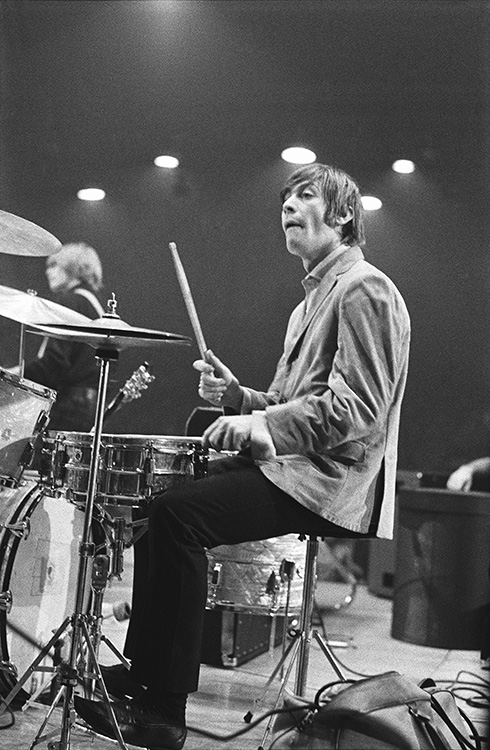Charlie Watts, one of the most legendary musicians in the world, wasn’t a typical rock star. With his neat suits and composed mannerism, Charlie resembled more a lawyer or a member of the gentry rather than a drummer of The Rolling Stones. Regardless, he was an essential member of the band, providing a unique rhythm and beat that would go on and define their music. When we think about rock musicians, everyone usually imagines the stereotype of rock star who indulges in drugs, is erratic and flashy, and is almost always on a straight-arrow path to decadence. Perhaps, this is why Charlie Watts was so engaging, with his unusual demeanor, and attitude in keeping his private matters away from the media. Unfortunately, Charlie passed away in 2021, which prompted many people as well as his fans to reflect on his impactful life, and the circumstances surrounding his death.
Who was Charlie Watts?
Widely considered one of the great drummers of all time, Charlie Watts was an English musician who gained international fame as a member of the rock band The Rolling Stones. He was born on 2 June 1941, in Bloomsbury, London, England, to parents Charles Richard Watts and Lillian Charlotte. His father Charles worked as a truck driver for British Railways, while his mother Lillian was a factory worker. Charlie had one sibling, a sister named Linda.
He spent most of his life in Wembley, which was an area of North London targeted by Luftwaffe bombs in WWII. Like many others families whose houses were destroyed in the bombing, he lived in a prefabricated house where he met Dave Green. The two struck-up a friendship based on their infatuation with rock music that would last until Charlie’s death. Green, who would become a jazz bass player, once talked about finding records with Charlie, saying: ‘We discovered 78rpm records. Charlie had more records than I did. So we used to go to Charlie’s bedroom and get these records out.’

Charlie and his family relocated to Kingsbury, London where he enrolled into Tylers Croft Secondary Modern School from 1952 to 1965. During his schooling, he displayed an interest and talent in music, art, and sports, mainly cricket and football. At the age of thirteen, he became interested in drumming: ‘I bought a banjo, and I didn’t like the dots on the neck. So I took the neck off, and at the same time I heard a drummer called Chico Hamilton, who played with Gerry Mulligan, and I wanted to play like that, with brushes. I didn’t have a snare drum, so I put the banjo head on a stand.’
In 1955 his parents gifted him his first drum kit, and he began practicing through listening to his numerous jazz records. After matriculating, he enrolled at Harrow Art School, which is today known as the Harrow campus of the University of Westminster.
Career
After graduating in 1960, Charlie worked as a graphic designer for Charlie Daniels Studios, and played drums with local bands in shops and clubs. He and his childhood friend Dave really kicked-off their musical career playing in the jazz band Jo Jones All-Stars. He said of his musical transition: ‘I went into rhythm and blues. When they asked me to play it, didn’t know what it was. I thought it meant Charlie Parker, played slow.’
Then in 1961, he befriended Alexis Korner, the lead singer of the band Blues Incorporated, who soon invited Charlie to join the band. Even though Charlie was supposed to stay in Denmark, where he worked as a graphic designer, in 1962 he took-up Alexis’ offer after returning to London. He played with the band in the following period, while simultaneously working at the advertising firm Charles, Hobson, and Gray.
The Rolling Stones
In 1962 Charlie met Brian Jones, Ian Stewart, Mick Jagger and Keith Richards, who were also avid musicians with some years of experience playing in local pubs and coffee shops. Mick and Keith joined Blues Incorporated, but Brian was adamant about founding his own band. The first Stone that Charlie met was Brian; in an interview, Charlie talked about him and their encounter, saying: ‘It was his band, really. He was the one with the passion. Brian also played slide and steel, things that people didn’t play. He’d play like Elmore James. We used to go to dances, and he’d be playing [James’s] Dust My Broom. Nobody had heard of this stuff.’ The band was without a name for a while, and then Brian drew inspiration from Muddy Water’s song “Rollin’ Stone.”
Charlie didn’t become a band member immediately, because the band couldn’t afford him, as at the time, Charlie regularly performed, earning a decent salary from his gigs. He officially joined the band as a permanent member in February 1963, performing with The Rolling Stones at the Ealing Jazz Club – Mick Jagger often introduced him as “The Wembley Hammer” during their live shows, and the nickname stuck.
In addition to his other-worldly rhythms, Charlie also used his abilities as a graphic designer, and contributed to the art and comic strips of their band’s early records, one of those being the sleeve for their fifth album “Between the Buttons.” He also organized the tour press conference announcement in 1975 in New York City, where they caught the fans off guard, simultaneously driving and playing “Brown Sugar” in the middle of Manhattan. Charlie was responsible for numerous other changes and novelties in their advertising and performances – Charlie and Mick designed the intricate stages for their tours, including “Tour of the Americas,” “Steel Wheels/Urban Jungle Tour,” and the “Licks Tour.”
His last live concert with the “Rolling Stones” was in 2019 in Miami, Florida – Charlie never missed a show throughout their five-decades of a successful career. In addition, Charlie, Mick and Keith are the only members who featured on every album.
Charlie’s Habits, Style, and Jazz
Charlie was well-known as a person who liked to keep to himself, rather than be the center of attention. While he might have seemed stoic to the fans compared with the energetic and colorful Mick Jagger and Keith Richards, it seems that he also had a wild side. According to a media outlet, Charlie enjoyed dancing and losing himself in the rhythm, just not in front of people, which is interesting given his status as a rock star. Furthermore, he also had a small ritual before performing – a cool little dance to get into the mood, often joined by his band mates.
Unlike most rock stars, Charlie was never fond of giving interviews and talking about himself. However, on several occasions, he proved that he was more than talkative about the subjects he liked, such as jazz and his personal style. Charlie said: ‘The lovely thing about jazz guys in that period — the fifties and sixties — was that they were very handsome men — Duke Ellington, Lester Young, Charlie Parker, Miles Davis — but they were also very stylish.’ His first love, jazz, influenced his style, as most jazz performers wore nice suits. During an interview with GQ, he revealed that he had had two tailors in England, and over 200 hundred suits.
Although he genuinely enjoyed having a unique style and changing his numerous suits, he was aware that his aesthetics didn’t go well with other band members’ dress code, revealing: ‘I always felt totally out of place with The Rolling Stones,” Watts said. “Not as a person; they never made me feel like that. I just mean the way I looked. Photos of the band would come back — I’ll have a pair of shoes on, and they’ve got trainers.’
Keith Richards on Charlie’s role in the Band
Suppose you ask any Rolling Stone who was the most influential musician of the band – the majority will point the finger at frontman Mick Jagger, and his controversial, attention-grabbing behavior and style. Or at least the guitarist Keith Richards, known as a peacemaker and a very outgoing person. However, in an interview with Rolling Stone magazine in 1979, Keith talked about Charlie and his role: ‘Everybody thinks Mick and Keith are The Rolling Stones. If Charlie wasn’t doing what he’s doing on drums, that wouldn’t be true at all. You’d find out that Charlie Watts is the Stones. When we got Charlie, that really made it for us.’
Despite Keith’s comment about Charlie after he died, the band opted to continue touring, which shocked the fans, replaced by Steve Jordan, Keith’s long-time collaborator. Steve had been taken as Charlie’s initial replacement, after he began experiencing various health problems. Over the years, he would fill in for Charlie, who was allegedly very impressed by his talent for drumming.
Charlie’s Alcohol and Drugs Abuse
Even though Charlie always exuded an aura of the most stable Stone compared to others, he also had his vices. In the ‘80s, the band struggled to make hits, and there were disagreements between Keith and Mick, which many believe could have been the end of the legendary band. Keith wanted to do tours, while Mick wanted to focus on his solo career. Charlie said: ‘The terrible time in the mid-’80s was everything else from a romantic role play. It seemed so innocuous to begin with, but then it went downhill for me at an insane rate. Soon you don’t know what you are doing anymore.’
He also had some personal problems, which prompted him to find solace in drugs. In an interview, he openly talked about his addiction and its consequences, disclosing: ‘Maybe towards the end of 1986, I hit an all-time low in my personal life and my relationship with Mick. I was mad about drink and drugs. I became a completely different person, not a nice one. I nearly lost my wife and family and everything.” At some point, the drug use became an everyday activity, and there were times when he would pass out in the studio – Keith would have to pick him up and help him regain consciousness. Charlie added that even Keith, also known for indulging in drugs, reprimanded him and said: ‘This is the sort of thing you do when you’re 60.’
So how did he conquer his addiction? He eventually realized that he couldn’t continue using drugs as it caused numerous problems in his life. Charlie credited his wife as his biggest support in battling his demons, sharing: ‘I just stopped cold – for my wife and for me. It was never me, really,”
Charlie’s Health Issues and Death
Charlie quit smoking in 2004, but was later diagnosed with throat cancer; saying: ‘On the slide, it had tiny cancer cells on it. You have cancer of the whatever. And that night, I thought I was going to die. I thought that’s what you did. You get cancer and waste away and die.’ Luckily, the cancer was benign, and doctors wanted to take it out; subsequently, Charlie underwent chemotherapy and two operations – according to his statements, this unpleasant experience triggered him, and made him face his mortality. Despite his fear, which was understandable, he pulled through, and the cancer was in remission.
However, on 4 August 2021, he experienced another critical health situation that forced him to pull out of The Rolling Stones’ “No Filter Tour.” According to media outlets, he had to undergo an “emergency medical procedure,” which prevented him from playing. Even though many hoped that he would make it again and continue touring, he passed away on 24 August 2021. The official Rolling Stone site announced it on Twitter, writing that the 80-year-old Charlie ‘had passed away peacefully in a London hospital earlier today surrounded by his family. Charlie was a cherished husband, father, grandfather, and member of The Rolling Stones, one of his generation’s most remarkable drummers.’ Although the exact cause of his death was never revealed, many concluded that it might have had something to do with his cancer, or various complications of old age.
A very sad day. Charlie Watts was the ultimate drummer. The most stylish of men, and such brilliant company. My deepest condolences to Shirley, Seraphina and Charlotte. And of course, The Rolling Stones.
@therollingstones #CharlieWatts #RIP pic.twitter.com/9rjSSgioZL
— Elton John (@eltonofficial) August 24, 2021
At the time of his death, his wealth was estimated to be over $250 million, which he left to his wife and children.
The Disastrous Concert at Altamont
The Rolling Stones are well-known for their ground-breaking hits, and are one of the most influential and successful rock bands of all time. However, several years into their career, they experienced a show they had never hoped to happen. In December 1969, the band was performing a free concert at Altamont, California, which was meant to be a happy, hippy, Woodstock type of show; unfortunately, the show was anything but joyful. The trouble began 20 hours before the concert, when the location was changed to Altamont Speedway, a treeless area. In addition, the sound system wasn’t working correctly, being significantly underpowered, which caused a lot of displeasure among the spectators, and Hells Angels who grew impatient and angry. Besides poor organization, it didn’t help that no one informed the surrounding landowners about the event, so they were naturally very hostile when they saw a crowd of people using their land as toilets.
The final result was an disaster; the moment the band hit the ground, Mick Jagger was hit in the face. With every performer, the crowd was becoming increasingly violent, and by the time The Rolling Stones began to perform, the whole event had turned into a bloodbath. The unfortunate event resulted in the death of Meredith Hunter, who was stabbed by a biker. The ordeal shocked the band mates and the Altamont community, who were outraged and shocked at the concert’s culmination. A total of four people died at Altamont that day.
Charlie Watts’ death was a massive loss to his family, fans, and the music industry. He will always be remembered as the Wembley Hammer, whose drum beats defined rock music and laid the ground for other artists, not only The Rolling Stones.





